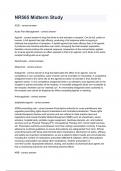NR565 Midterm Study
ACEI - correct answer-
Acute Pain Management - correct answer-
Agonist - correct answer-A drug that binds to and activates a receptor. Can be full, partial or
inverse. A full agonist has high efficacy, producing a full response while occupying a
relatively low proportion of receptors. A partial agonist has lower efficacy than a full agonist.
It produces sub-maximal activation even when occupying the total receptor population,
therefore cannot produce the maximal response, irrespective of the concentration applied.
An inverse agonist produces an effect opposite to that of an agonist, yet it binds to the same
receptor binding-site as an agonist
Alendronate - correct answer-
Allopurinol - correct answer-
Antagonist - correct answer-A drug that attenuates the effect of an agonist. Can be
competitive or non-competitive, each of which can be reversible or irreversible. A competitive
antagonist binds to the same site as the agonist but does not activate it, thus blocks the
agonist's action. A non-competitive antagonist binds to an allosteric (non-agonist) site on the
receptor to prevent activation of the receptor. A reversible antagonist binds non-covalently to
the receptor, therefore can be "washed out". An irreversible antagonist binds covalently to
the receptor and cannot be displaced by either competing ligands or washing.
Anticoagulants - correct answer-
antiplatelet agents - correct answer-
APRN prescribing role - correct answer-Prescriptive authority for nurse practitioners also
regulates prescribing rights beyond medications and controlled substances. These rights
include therapeutic devices and services and are outlined in state practice laws and
regulations and include Durable Medical Equipment (DME) such as wheelchairs, power
scooters, hospital beds, portable oxygen equipment, handicap placards, etc. and medical
services such as Physical Therapy (PT), Occupational Therapy (OT), home health services,
etc. Prescriptive authority encompasses more than writing a prescription correctly. It requires
adherence to ethical guidelines to ensure that patients are safeguarded from harm. Ethical
prescribing starts with being well-informed about medications. Mechanism of action, efficacy,
and safety are important considerations, as are a patient's distinct needs and circumstances,
including the number of medications prescribed (Mitchell & Oliphant, 2016). Most patients
receiving a prescription are taking other medications, whether prescription or
over-the-counter. Appropriate selection, dosing, and duration of pharmaceutical agents are
key to maximizing outcomes and minimizing adverse effects
ARB - correct answer-
, Assessing and Addressing OUD - correct answer-
Beer's Criteria - correct answer-identifies drugs with a high likelihood of causing adverse
effects in older adults. Accordingly, drugs on this list should generally be avoided in adults
older than 65 years except when the benefits are significantly greater than the risks.
benefits of full practice authority - correct answer-Nurse practitioners have the autonomy to
evaluate patients, diagnose, order and interpret tests, initiate and manage treatments and
prescribe medications, including controlled substances without physician oversight
Beta-blockers - correct answer-β blockers (e.g., propranolol, metoprolol) are first-line drugs
for angina of effort, but are not effective against vasospastic angina
β blockers should not be used by patients with sick sinus syndrome, heart failure, or
second-degree or third-degree AV block.
β blockers reduce anginal pain primarily by decreasing cardiac oxygen demand, principally
through blockade of β1 receptors in the heart, which decreases heart rate and contractility.
β blockers should be used with caution by patients with asthma. If an asthmatic individual
absolutely must use a β blocker, a β1-selective agent (e.g., metoprolol) should be chosen. β
blockers can mask signs of hypoglycemia and therefore must be used with caution in
patients with diabetes.
When starting or restarting sotalol, patients should be in a facility that can provide
continuous electrocardiogram monitoring and cardiopulmonary resuscitation for a minimum
of 3 days to minimize problems associated with induced arrhythmia.
Creatinine clearance should be established before initiating this drug.
Betapace cannot be substituted for Betapace AF when treating atrial fibrillation.
Therapeutic Goal: Principal indications are hypertension, angina pectoris, heart failure, and
cardiac dysrhythmias. Indications for individual agents are shown in Table 16.5.
Baseline Data: Heart rate, blood pressure (supine, sitting, and standing depending on patient
status), ECG (if indicated by patient age and status), and general cardiovascular status
Monitoring: Heart rate, blood pressure, evaluation for adverse effects (with symptom-focused
assessment if indicated). Advise patients to record the incidence, circumstances, and
severity of any symptoms that may indicate inadequate control of symptoms for which the
drug is given (e.g., angina) or a new onset of adverse effects.
Identifying High-Risk Pat
Calcium Channel Blockers - correct answer-The CCBs used most frequently are verapamil,
diltiazem, and nifedipine (a dihydropyridine-type calcium channel blocker). Accordingly, our
discussion focuses on these three drugs. All three can block calcium channels in VSM,
primarily in arterioles.
Verapamil and Diltiazem




